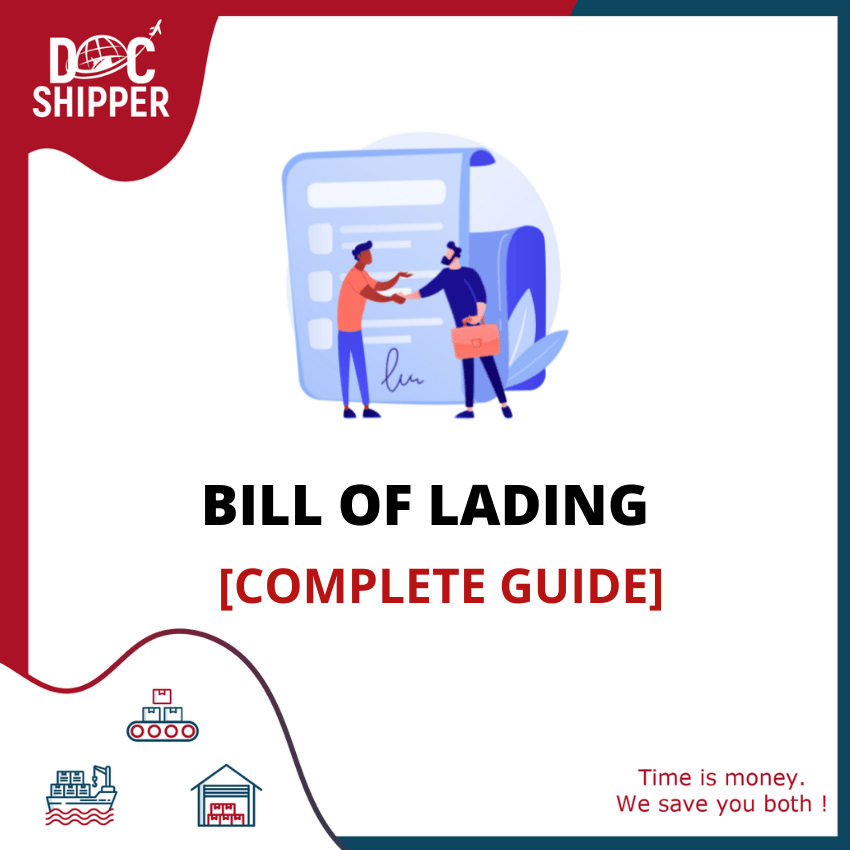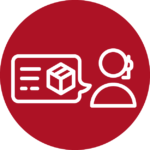Table of Contents
Are you a beginner in worldwide exchange and when you make your first exchange, the word Bill of Landing doesn't appear to be recognizable to you? Relax, we will feature the attributes of this renowned record, since in the business world, the Bill Of Lading (BoL or B/L) is one of the primary reports used to do ship exchanges via ocean, air or street.
The Bill of Lading is an document given by a carrier to a shipper, affirming that the merchandise have been gotten in an acceptable condition and are prepared for shipment. These merchandise will then, at that point be conveyed by the transporter to a recipient. At long last, the Bill of Lading is an agreement of carriage between the transporter, the proctor and the transporter setting out the states of carriage. In this article we will introduce you with this document so you can get what it is and how to react.
DocShipper info : Interested in our freight forwarding services? Let us now about your need by filling out this form. Our experts are also available to answer all your questions by phone.
What is a Bill of Lading?
The Bill of Lading is a document given by a carrier to a shipper, affirming that the merchandise have been gotten in an adequate condition and are prepared for shipment. These products will then, at that point be conveyed by the carrier to a consigee. At last, the Bill of Lading is an agreement of carriage between the shipper, the consigee and the carrier setting out the states of carriage.
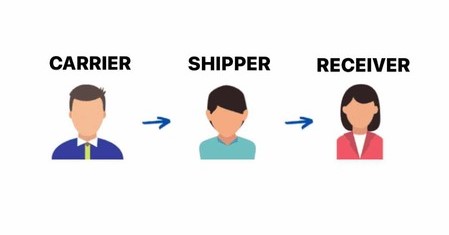
What is the purpose of a Bill of Lading?
The bill of lading can serve as an acknowledgement of receipt of goods.
Shipments can't be executed without a Bill of Lading. Bills of Lading should be given for merchandise to head out from point A toward point B. It is an document where the transporter or his representative recognizes receipt of the merchandise depicted in that for carriage via ocean.
The bill of lading acts as a title to the goods.
When the products have shown up at their destination, the Bill of Lading acts as title to the merchandise. The named consignee should introduce the Bill of Lading to get the arrival of the shipment from the carrier and to guarantee possession. In this sense, it is a proof of affirmation of delivery.
The bill of lading also guarantees payment to the shipper.
Sometimes, the shipper might hold the first Bill of Lading until payment is received. In this sense, the consignee can not get to his products until the payment has been made and the Bill of Lading delivered.
DocShipper Tips : DocShipper can handle your freight shipping from A to Z, from the supplier's warehouse to the final destination. Our multilingual team will handle all the necessary paperwork and communication with the logistics providers. For more information or to receive a free quote within 24 hours, please fill out the form.
Who uses the Bill of Lading?
Commonly, organizations giving transportation administrations produce Bills of Lading. This incorporates proprietor drivers, cargo forwarders, outsider coordinations organizations and others. At last, these are organizations that transport merchandise using any and all means, regardless of whether via air, ocean, rail or street.
They can be utilized for public and worldwide conveyances.
What does the Bill of Lading consist of?
- Carrier, shipper and representative subtleties
- The area where the merchandise were loaded
- The objective of the merchandise
- The transport mode (street, rail, air, ocean, and so on)
- The states of the shipment, the incoterms
- A portrayal of the merchandise moved (assignment, weight, measurements, grouping, and so forth)
Docshipper Alert: If your documents are not in order when you import your product, your goods may very well be seized. As a result, you must ensure that your goods have all of the necessary documentation to prove their conformity. To avoid taking unnecessary risks, do not hesitate to contact our DocShipper experts. They will help you get through customs without any obstacles
Accuracy is essential
Mistakes in Bill of Lading planning have caused calamities for some transportation organizations. For instance, in 2019, a cargo forwarder was requested by a New South Wales court to pay more than $800,000 in damages for "tricky lead" in light of the fact that the bills of replenishing caused them to give off an impression of being sea transporter solicitations (when they were not).
Who issues the bill of lading?
The "transporter" is the solitary organization that can give the Bill of Lading. When dispatching by sea cargo, the transporter might allude to the transportation organization (Vessel Operating Common Carrier) or to a NVOCC (Non-Vessel Operating Common Carrier) otherwise called a cargo forwarder (although not all cargo forwarders are NVOCCs).
Who is the Bill of Lading for?
Bills of Lading are regularly accommodated:
- The transporter
- A customs broker or cargo forwarder
- The consignee- the individual who bought the merchandise.
Example: If the merchandise are imported by a cargo forwarder on EXW terms (once more, refer to the Incoterms), this is the course of the Bill of Lading
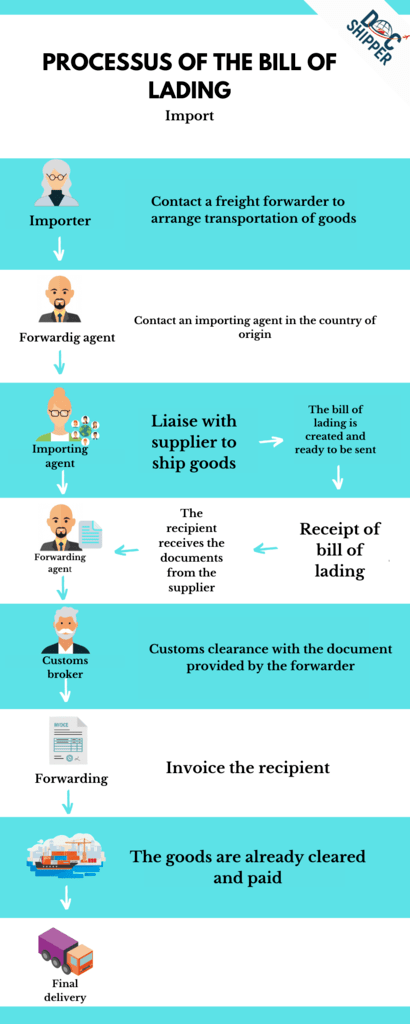
The different types of Bills of Lading
There are a wide range of kinds of Bills of Lading. They contrast contingent upon many factors like the issuer, the topic, the type of transmission, the connection between the purchaser and the merchant, and the insurance it offers to the buyer.
The principle kinds of Bills of Lading prepared for worldwide transportation are the Ocean Bill of Lading, SeaWay Bill of filling, HouseWay Bill of Lading, Master Air Way Bill of Lading, House Air Way Bill of Lading and here and there is the Switch Bill of Lading. We will depict each of these below. Above all, there are two primary classifications you need to think about: negotiable and non-negotiable Bills of Lading.
Negotiable Bills of Lading VS Non-Negotiable Bills of lading
An original Bill of Lading is a negotiable and authoritative report since it addresses title to the merchandise. Non-negotiable Bills of Lading are real duplicates of the firsts however have no control over the title of the merchandise. Original (negotiable) Bills of Lading should be embraced by the consignee as an actual look at when moved to an outsider, for example, a cargo forwarder.
At the point when the load moves under a negotiable status, it is the obligation of the cargo forwarder to guarantee that it is gone over to a proper authority. At the point when load travels through the NVOCC administrations of the cargo forwarder (non-vessel possessing normal transporter), the cargo forwarder should guarantee that the first (negotiable) receipt is gone over to them prior to delivering the consignee or their representatives.
Inability to do as such would consider the transporter responsible for the worth of the payload if the transporter/representative agreement isn't satisfied.
Note that the two terms apply to sea cargo as it were. For airship cargo, the terms are Master Air Way Bill (MAWB) and House Air Way Bill (HAWB). In any case, not at all like sea cargo, Air Way charges are negociable non-negociable archives except if they are dispatched through a bank.
Ocean Bill of lading
These are produced by delivery lines as the transporter for this situation of compartments traveling via ocean and is for the most part utilized when the transporter wishes to hold control of installment by the consignee (buyer) for the products. The first Bill of Lading will be utilized to guarantee that installment is made before the merchandise are given over to the consignee.
Whenever the payment is received, the report can be prepared severally, contingent upon what the transporter makes accessible.
The first Bill of Lading can be given to the transporter for a wire form (an advanced adaptation of the BoL).
The first Bill of Lading is sent by dispatch to the representative for show to the transporter for release.

Sea WayBill Of Lading
This is a non-negotiable report gave in lieu of a Bill of Lading where the transporter doesn't have to control the arrival of the cargo.

House Bill Of Lading (HBoL)
At the point when cargo is organized by sea cargo through a NVOCC/forwarder, an internal Bill of Lading is produced. This can be organized as a negotiable or non-negotiable choice relying upon the transporter's prerequisites. At the point when a non-negotiable alternative is utilized, it might now and then be alluded to as an express Bill of Lading.
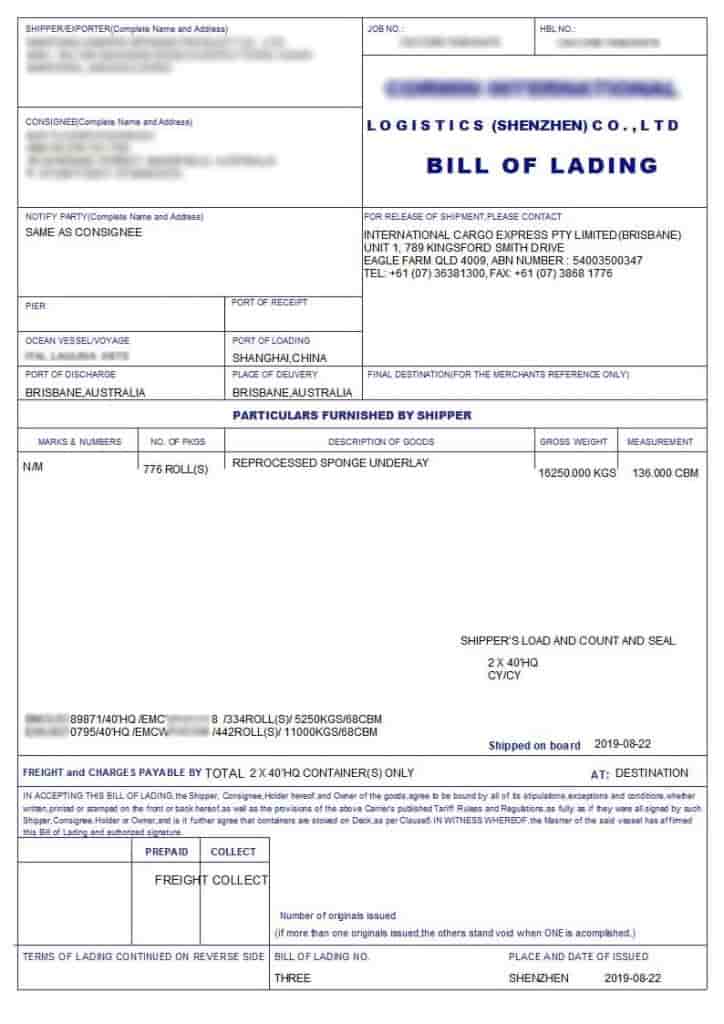
House AirWay Bill Of Lading
This is the Air Way Bill that is given by a cargo forwarder for merged air freight shipments. HAWBs are dealt with precisely equivalent to MAWBs, if they demonstrate that the issuer is accepting accountability as a transporter or is going about as a specialist for an assigned transporter.
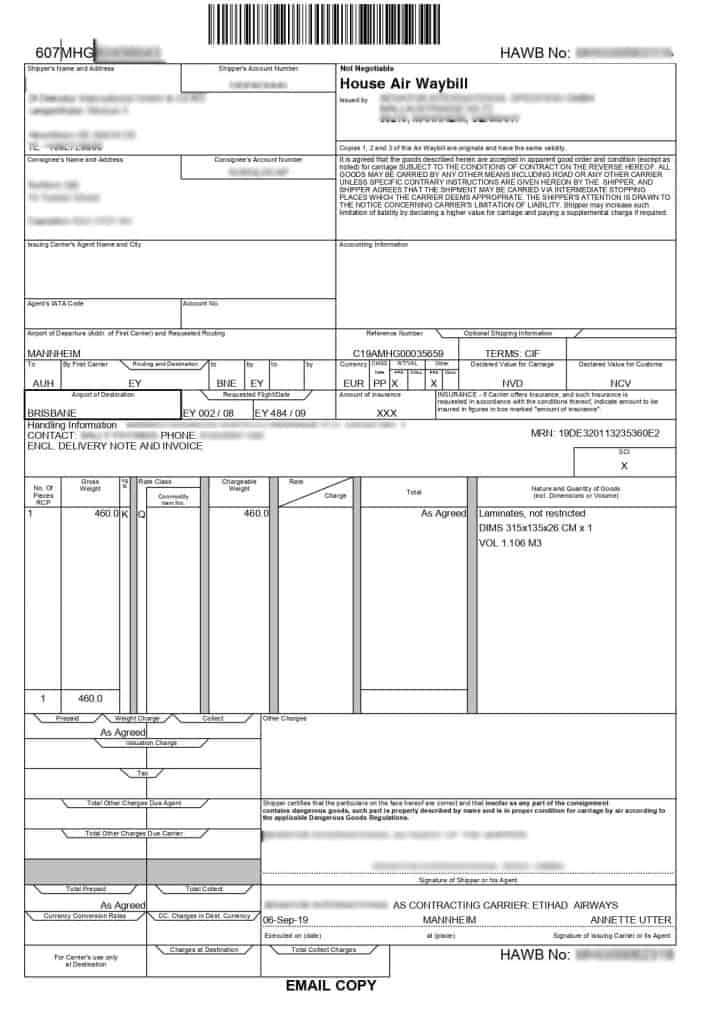
Master AirWay Bill Of Lading
Expert Air Way Bills (MAWB) are carrier Bills of Lading for air freight. They are non-negotiable records, aside from when the shipment is transported "on hand". This normally implies that the shipment has been haggled through a bank, in which case an authentication from the bank being referred to should be introduced before the payload is delivered by the transporter.
Regularly, they are organized from forwarder to forwarder and a House Air Way receipt is produced from transporter to recipient.
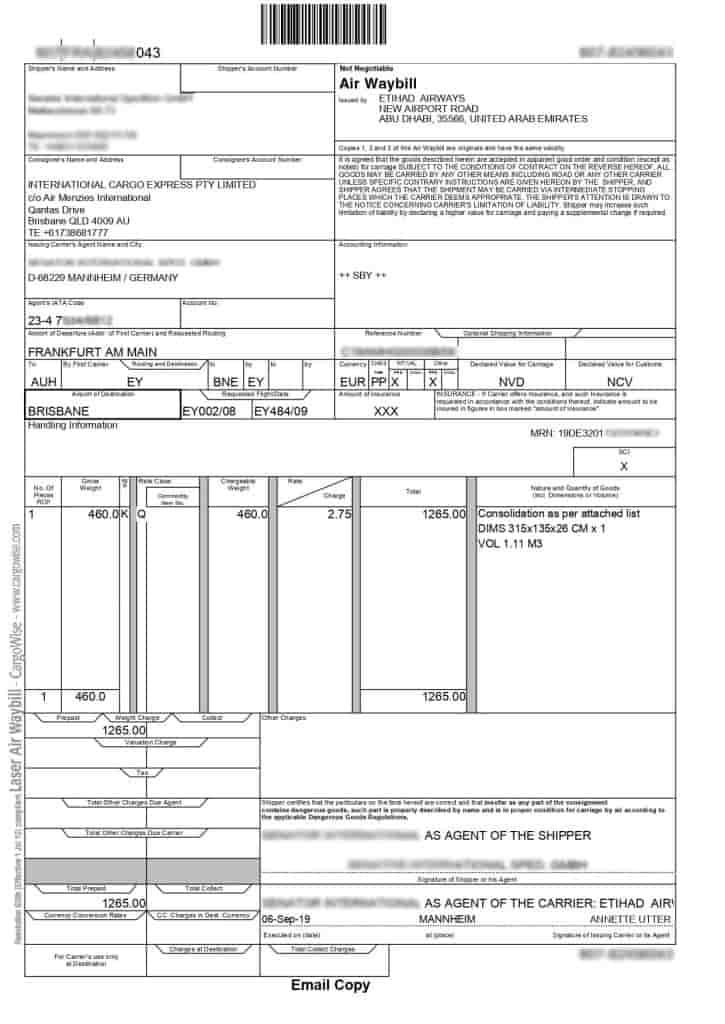
Multi-modal bill of lading
This is the point at which you utilize more than one kind of transportation. For instance, you might utilize rail for part of the excursion, then, at that point road for the rest.
Straight of lading
This is a sort of sea Bill of Lading format that is utilized when the merchandise are settled up on completely and conveyed straightforwardly to the consignee (for example the individual or association that bought the merchandise in the first place).
Switch Bill of lading
At the point when products should be moved and provider data should be kept confidential - regularly on account of a Triangle shipment where a purchaser offers to a third party, a second BoL is created by supplanting the first with the refreshed data.
Through Bill of Lading
These Bills of Lading are for merchandise shipped beyond what many would consider possible via ocean, then, at that point by road or rail to the last objective. Ensure they are not blended in with multimodal Bills of Lading.
Dirty/claused Bill Of Lading
This term is utilized when merchandise are gotten by the transporter in a damaged condition. Contrast this with a "clean" Bill of Lading, where the merchandise are delivered in satisfactory condition.
Electronic Bill of Lading - Telex and Express version
The telex and express version are not kinds of Bills of Lading, however techniques for giving the Bill of Lading.
A telex discharge is essentially an EDI message or email sent by the transporter or specialist at the port of stacking to their agent at the port of release, informing them that the transporter has given up one or the entirety of the first Bills of Lading gave to them. On this basis, the specialist at the port of release might release the load to the named consignee showed on the Bill of Lading without show of any original Bill of Lading.
The Express Release Bill is like the Telex form in that it can't be computerized. Notwithstanding, the thing that matters is that with the Express form, no paper duplicate of the Bill of Lading is given. Without the production of originals, the Express form offers many benefits, yet ought to just be utilized in quite certain conditions.

Why are INCOTERMS important?
Your decision of Incoterms will decide how the whole process is managed. Before you proceed, look at our Beginner's Guide to Incoterms 2020 to see how the two interface.
Incoterms can be muddled to use, as it relies upon the idea of the business and the products being taken care of.
You need to decide precisely the thing terms you are delivering under with the goal that it is clear who is answerable for which piece of the transportation process.
FAQ - BILL OF LADING [COMPLETE GUIDE]
Can it be a Bill of Lading without any consignee ?
No, a consignee is compulsory on a Bill of Lading. There is only one case in which a Bill of Lading can be delivered without a consignee is when this to somebody other than the acquiring party or their named address is the point at which a shipment is masterminded on a Letter of Credit (L/C) which will here and there require the bill of replenishing to be dispatched 'To Order'.
The BL number is given for a single shipment or per holder?
Contingent upon the solicitation of the client (forwarder or exporter or the transporter), a Bill of Lading can be given per shipment or per compartment. There might be 1 holder and 3 Bills of Lading or it can be 3 compartments for 1 Bill of Lading. The quantity of Bills of Lading for the shipment or compartment might be directed by the agreement, buy request or letter of acknowledge, just as the kind of Bill of Lading and the quantity of firsts/duplicates to be given.
Can a delivery be made without the Bill of Lading ?
Shipments can't be executed without a Bill of Lading. BoLs should be given for merchandise to venture out from Point A to Point B. They are lawfully restricting records, and they frequently fill in as confirmation of responsibility for merchandise being conveyed. A bill of Lading additionally covers its job as title to merchandise.
Is it the delivery compagny that gives the OB/L number or is it the cargo forwarder ?
The OB/L number is a remarkable number doled out by the delivery organization and is the essential number used to follow the situation with the shipment. The Bill of Lading number is produced and doled out by the cargo forwarder.
DocShipper info: Do you like our article today? For your business interest, you may like the following useful articles :
DocShipper Advise : We help you with the entire sourcing process so don't hesitate to contact us if you have any questions!
- Having trouble finding the appropriate product? Enjoy our sourcing services, we directly find the right suppliers for you!
- You don't trust your supplier? Ask our experts to do quality control to guarantee the condition of your goods!
- Do you need help with the logistics? Our international freight department supports you with door to door services!
- You don't want to handle distribution? Our 3PL department will handle the storage, order fulfillment, and last-mile delivery!
DocShipper | Procurement - Quality control - Logistics
Alibaba, Dhgate, made-in-china... Many know of websites to get supplies in Asia, but how many have come across a scam ?! It is very risky to pay an Asian supplier halfway around the world based only on promises! DocShipper offers you complete procurement services integrating logistics needs: purchasing, quality control, customization, licensing, transport...
Communication is important, which is why we strive to discuss in the most suitable way for you!

